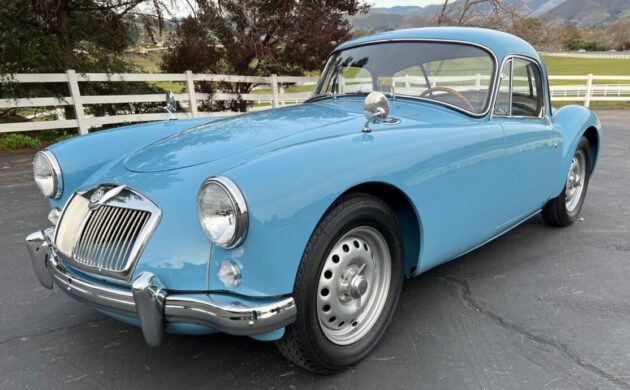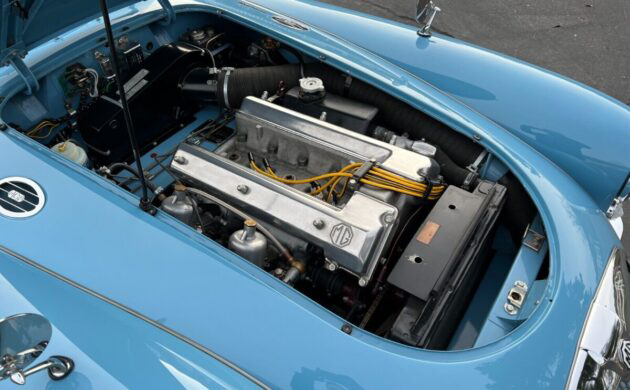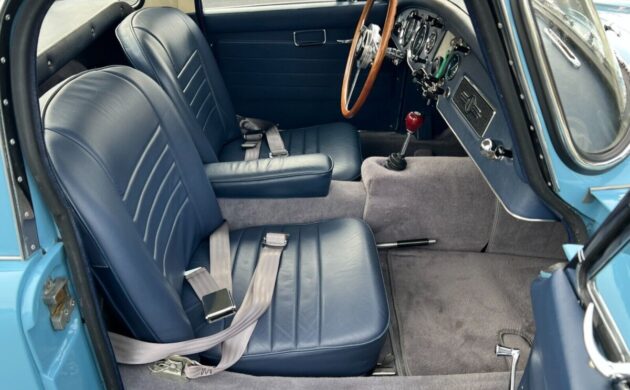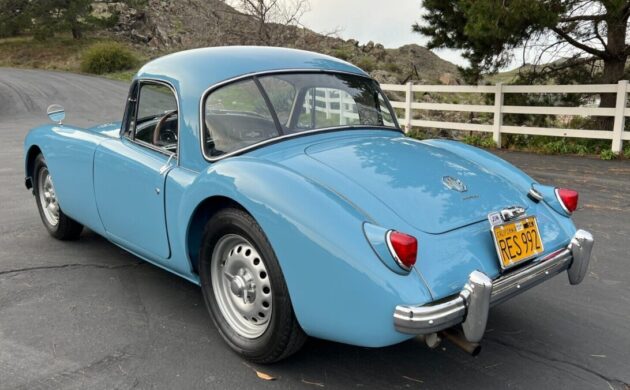The MGA was a fabulous machine, but it was deemed not quite fabulous enough. Its four-cylinder engine wasn’t suitable for serious racing and after a less-than-satisfactory result at Le Mans in 1955, the factory accelerated its efforts to equip the sleek car with a better engine. Fortunately, such a motor was already in the works, conceived by Gerald Palmer. Palmer was a design engineer working with the venerable B-series block; he was responsible for the ZA Magnette. Palmer thought the Magnette could become a GT car with a better motor, so in about 1954 he designed a twin cam based on the B-series. He failed to convince management to enhance the Magnette, but the twin cam motor was definitely of interest. In 1958, Palmer’s design was finally adopted into the MGA – MG’s first production overhead cam motor since the PB in 1934. The new car received Dunlop center lock disc wheels – wires were not offered nor were they desirable on this race-bred car. Braking was via Girling discs front and rear. Chassis alterations were completed to fit and support the new motor. Top speed had improved and the factory eagerly awaited sales. However, initial excitement turned to dismay as the cars began to fail right and left. Engineering flaws in the underdeveloped motor were largely at fault, and MG – after applying many fixes – pulled the plug on the Twin Cam after only 2111 had been sold. Here on eBay is a 1959 MGA Twin Cam coupe benefitting from a nut and bolt restoration, bid to $30,100, reserve not met. The car is located in San Luis Obispo, California.
Here’s the culprit, MG’s 1588 cc twin-overhead cam four-cylinder, good for 108 bhp and a top speed of 113 mph. Before we discuss the engine’s flaws, it’s worth noting that renovated Twin Cams today are more reliable thanks to minor re-engineering and better materials. But out of the factory, several problems arose. The crank dog interfered with the steering rack; dynamo brackets cracked; tappets shattered and when trial and error around sizing failed, it was discovered that the material itself was poorly suited for the job; the timing chain is quite long and prone to stretch; oil consumption was legendary; but the big one was holed pistons. The motor produces a resonance at 2500 and 5500 rpms that contributes to fuel starvation, leaning out the mixture and holing pistons right and left. The fix is a simple flexible mount for the carbs. Also, the emergency brake is funky – its design is not up to snuff relative to the big disc brakes. That said, this car’s engine bay could not be more perfect. Despite the ten years since its restoration, the brake master cylinder area and battery tray look like the car was finished yesterday. Note the label on the MC – “silicone”.
The interior is beautiful, with navy blue leather upholstery and light gray carpets. Coupes use dedicated seats that differ from the roadster’s; the windshield and other glass are unique; unlike the roadster, the coupe offers roll-up windows and door handles. The glass, regulators, and handles are very rare parts. It’s estimated that only some 300 MGA Twin Cam coupes were built, so finding a nice one is an achievement.
The Iris Blue paint shines with no discernible flaws. In front-end photos, the bonnet does not fit absolutely perfectly, and here we see a gap at the lower edge of the trunk lid and a gap at the trailing edge of the door – though it may not be shut tight. The rear bumper sags downward a bit. The underside is respectably clean and shows off the finned aluminum oil pan. These tiny flaws could be why this car failed to meet its reserve at an auction last October, ending at a high bid of $47,000. Meanwhile, there’s no question that MGA Twin Cam prices are falling generally, whether the car is nice or not. I put the Twin Cam into the same category as the Fiat 1200 TV or the Mazda Cosmo – quirky, beautiful sports cars that shot up in price for a while and are now drifting back to earth. This seller may wish he took the prior bid for this car.






Nice car. Your comments on the fit of the trunk lid and doors could be said of most of the MGs of the era. TR6s were another car with various gaps. We worked a lot of customer cars until we achieved even gaps, much to the customers disbelief. The Brits didn’t seem to care about details. The ’60 Sprite we are working on is a classic example with poor door and hood fit and some of the sloppiest welding I’ve ever seen. Even welded the left rear spring perch in crooked. I’d hope the engine bugs have been worked out of this car. It’s possible but the Brits didn’t take time to do it.
I think the A coupe is the best looking small sports car.
These are special but as the author points out they weren’t able to get them across the finish line per say. Had an acquaintance many years ago who was into sports cars. What I didn’t know at the time was how rare these were and my car was an older ride so I went to junkyards, yep that’s what they called or wrecking yard. Anyway I found a twin cam MGA in a yard, he was there stripping the car to next to nothing with a couple of guys the next few days . Never have seen one running and driving but I helped to save at least most of one that I am sure the parts we’re at least used later to save another. Back then recycling wasn’t like it’s done today. Many sat there for maybe a few months and were pulled apart , not gently and scraped.
I looked at and drove a white MGA Coupe twin cam in 1961 in California.
It had lots of problems with seal leaks and rough running. I had a nice MGA
roadster and would not have traded even money for the same model year.
The coupe body style is the best looking of the MGA’s…and with a twin cam motor.This is a beautiful car
Most Jags and MGs look best as a convertible, I’ve never cared much for those that have a “hard top”. I’ve never owned a Brit car (had car friends who were knowledgeable) and told me that they look good, but the body work left a lot to be desired, unless it was a Bentley or a Rolls.
You mean you don’t like the factory hard top on my ’62 Midget? Bet you would if you were in upper Michigan in the winter.
An MG midget — LOL!!!! Take a tiny sports car and make a midget size of it — HA HA HA — that’s got to be the weirdest funniest thing English car makers ever did!! At least the hard top on it is flat and isn’t bubbled up like a clown car. That was an improvement… among so few they did.
What is a crank dog please?
How can something that interfered with steering make it to production?
Best to “google”…. crank dog nut
Ha! Thanks.
Hence the crank in the toolkit.
No joy there.
Lovely example of rare MG. I also prefer the look of the coupé, but am not sure I would want to live with one.
Comparatively good value against an Alfa Giulietta Sprint. Though the Alfa is a more sophisticated package, this MG is much rarer.
I had a ’62 MGA Mk II convertible in black with black interior (which I think they all had). – It had the English carburetors – twin single port – one for each two cylinders – which were a nightmare to synchronize – but when it was all tuned up perfectly, it purred and ran very well – for a few miles. As we used to say; if you buy an English car – you need a tiny mechanic that fit in the trunk to go along with it. — The convertible top was very easy to take down and put back up, and the plastic “side curtains” – the archaic English version of windows – stored easily behind the bucket seats, where a wooden – yes a piece of plywood covered in the same vinyl upholstery as the seats – plank covered an open-to-the-elements compartment directly in front of the rear wheels – where the 6 volt battery and electric fuel pump was housed. The electric fuel pump was annoying – it’s constant click click clicking was maddening when you had the top up with the side curtains installed. — However – the car was so low to the ground with rather large wheels for the size of the car – it stuck to the road and cornered almost as well as a Porsche with the Pirelli tires I put on the rims – and the little 4 cylinder pumped out enough hp – about 89hp – to push the tiny lightweight thing at a very fun clip going through the gears. The huge triple spoke steering wheel made steering very easy and steady. You could also feel the road through the steering wheel, which gave you real time feedback on how the wheels were gripping the road, which I thoroughly enjoyed. All in all, the little thing was a very fun car to drive – when it was running properly. Best of all – it wasn’t a hardtop – the really stupid-looking bubble – that we called the popcorn popper top. That had to be the very worst roof design – EVER – and I would not have had one with it. Good luck to the one who ends up with this MG version – the engine is a nightmare – and the looks belong in a clown circus.
Possibly the most uneducated design comment-EVER.
LOL!!!! You are comparing a race car twin carb setup to a ’62 MGA???!!! What a total LAUGH!!!! Not even close to the same quality between the two – not made at all to the same specs. The twin carb setup linkage in the English cars was very sloppy – to put it mildly – besides the fuel to air mixture adjustments – and getting them to not slip out of alignment with the constant vibration of the engine and the road was an exercise in needing to love to work on cars in your spare time. Talk about “uneducated” — you take the grand prize for that!!!! I also had a ’63 Austin Healey Mk III with triple carbs on its 6 cylinder engine. Those carbs were a vast improvement over what they were before in that short time – but still an exercise in patience when tuning the car up. GEEZ — know what you’re talking about before commenting on night and day comparisons!
I’m confused as to why everyone thinks the twin SU carbs are so hard to tune. All you have to do is push the gas pedal all the way down to see if the linkage on both carbs hits the stop at the same time and with the correct wrench adjust the jet at the bottom of the carb body. You can get a Unisen vacuum gauge, a stethoscope to listen the air flow, or if you are really cheap stick a rubber hose in your ear and listen through that until both carbs sound the same at the highest idle rpm. Reset the idle speed to the proper rpm with the two set screws and your done. Have two race cars with twin SUs on the engines and once they are set we usually just ignore them from there on.
Agreed. Plenty of other makes are more difficult to deal with.
I’m loving your preparation Bob, is there a specific reason why you’re sticking with twin 1”1/4s ?
Yes. They are required by the SCCA class we run in. We can modify them which we did by “through” boring the carbs and manifold to get as much air through as possible. Rules say numbered head and block and stock rear end housing along with the carbs, all modified in some form or another.
Nice MGA, Twin cams had problems years ago.
I agree with Bobtwin SU carbs are easy to tune I have had them on my MGB’s,and have never had a problem with them, & I tuned mine the same way as Bob suggested.
Does anyone ever understand what they read anymore? — By the time the MGB came around – the dual carbs linkage and fuel / air mixture adjustments had been improved — they even made improvements from “62 to ’63 as evidenced by the ones used on my Austin Healey Mk III that were much easier to keep set once you got them tuned. — BUT — the ’62 MGA did NOT have those improvements! GOT IT?!
“Set it and forget it.”
When I was 16 and was trying to get my first car a 1950 Packard, running, one of my girl friends father;s GAVE me a 1960 MGA that was literally sitting in the woods. I got it running but what happened after that I dont remember :) Probably stopped running and I just gave up :)
This is a beautiful car , Just need a MG guy to buy it to keep it running
OK, MGA Quiz time. Might as well clear the air here. The comments here are proloteriat, because we were the genre who could afford an MGA. Here we are clucking in the chicken coupes. HA! So, here is a laugh about interesting trivia for oldsters who know every nut, bolt, and screw on the MGA’s like me. There are a lot of us! HA! Who has the original part number of the only part originally fit to every MGA that IS pictured in the beautiful hand drafted illustrated maintainance manuel, yet ( to the best of my knowledge) has no part number. Does YOUR MGA still have the split cotter pin hanging loosly from the lowest hole in the bellhousing? I call it the “Oil drip Accumulator”. Is there a part number? Is that old BMC parts guru out there? Those were great times!
hahaha, nice one Jim. I called it the “giggling pin” always made the storeman laugh.
Pin does work though to keep road dirt from blocking the drain. Clutches really don’t like running in water, or in our case the oil that seeps out of the rear main bearing.
Al Dee getting a bit excited about multiple SU carburettors.
I have 10 SUs in my shed in single, twin and triple configurations. Dating from 1951 to 1971. They are beautiful, simple things and once tuned, walk away and forget about them.
No big trick to synching SU Carbs on MGA. Loosen linkage so both valves closed. Tighten linkage and set idle. Adjust idle richness per instructions.
I always had to try a couple times to be satisfied with results. Now adjusting needle metering inside the pots was something else. I finally found an expert who sent away for an improved set of needles that ran richer mid range. Must have been one of those later factory changes mentioned above.
Hooi….couldn’t have made an ugly car worse looking except for the nursury blue paint. Had a ’55 mga softtop in Europe for four years from 1957 on. Ran like a champ the whole time except for one time when soaked to the gills. Also had a 1967 B with no running problems for four years. Would take them both back but I don’t think I’d fit now.
U guys need to pick up some 4 carb bikes.
/OR/
use the Lynx 6 carb intake with 6 Mikunis
8^ )